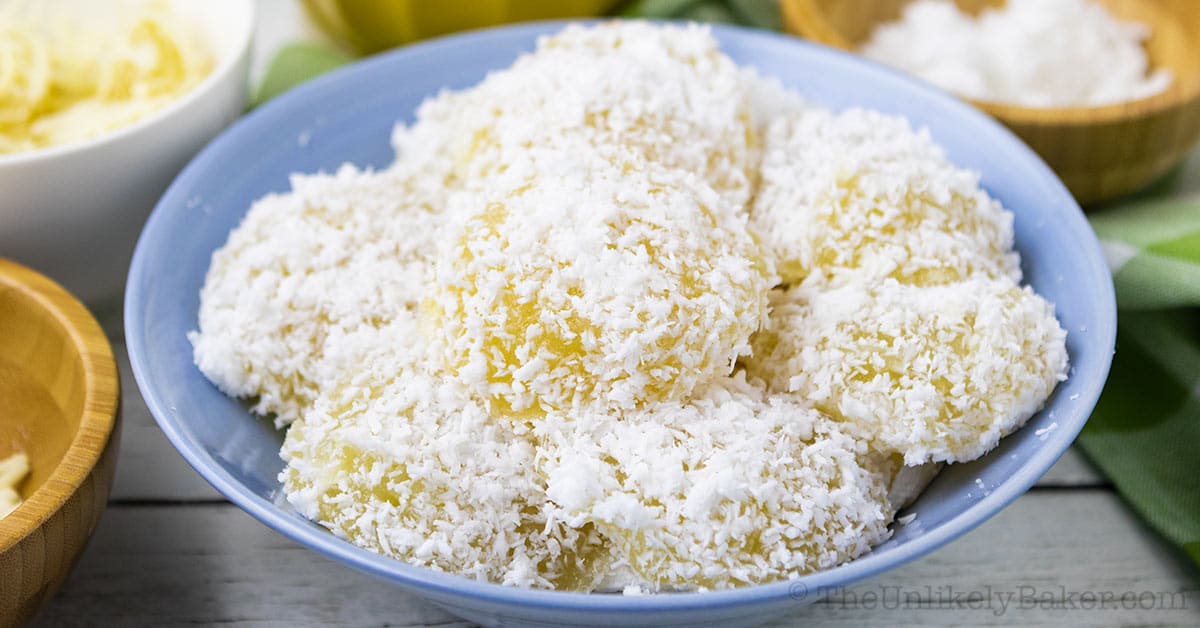

Pichi pichi recipe using cassava powder full#
It is best to finish up your cassava cake before a span of three days so we can still enjoy its full flavor. Some Variations You Could Tryįor some additional flavor to your cassava cake, it is also a good idea to add macapuno in your base mixture.Īnd another thing we can do after the cassava cake is baked is to add extra grated cheese at the top to make things a little bit more fancy and presentable. If that’s not the case, you can also get the ones which are frozen since it has a longer shelf life. You can use fresh cassava as the ingredient, but take note that it has to be used as soon as possible to achieve a delicious taste for your cassava cake. Once you do this, bake the cake once again until the top turns into a nice shade of golden brown.Īnd that’s it! An easy homemade cassava cake, ready to be served. We can now pour the toppings over the base and spread. You can cook it in low heat while doing this until it gets thick. Place them in a pan and mix them thoroughly until we can achieve an even consistency. Again, we will need the all-purpose flour, sugar, egg yolks, coconut milk and condensed milk. While waiting for the base to be prepared, we can now deal with the toppings. Mix together cinnamon and brown sugar to form a sweet and spicy topping for the toast. This will give the toast a rich and creamy flavor. Spread butter onto one side of each slice of bread. Once the tray has been preheated, all that’s left to do now is to bake it! This temperature will ensure that the toast comes out crispy and golden. Remember that the tray has to be preheated before we can put the base mixture into it. You can simply spread the oil as you like or pour about 1 teaspoon of oil and spread it evenly in the baking tray. Next, set up a baking tray and grease it with oil. This will only take a couple of minutes, so no worries.

You can use a whisk in mixing all of these ingredients until it looks nice and evenly distributed. Combine all the ingredients mentioned for the base and put it in one large mixing bowl. Now this will consist of two processes: making the base of the cake, and making of the topping.įor the base, of course–the most important one–we will need grated cassava, coconut milk, evaporated milk, condensed milk, eggs, brown sugar, butter or margarine, and cheese.Īnd for the toppings, we will need all-purpose flour, and coconut milk.įirst up, the base. There is completely nothing to worry about as the ingredients needed in making your delicious cassava cake at home is super easy to find, you probably have at least one, if not all, at your disposal right now.
Pichi pichi recipe using cassava powder how to#
So with all this in check, what are you waiting for? Let’s go and try to make Cassava Cake! How To Make Cassava Cake? It is a good source of vitamin C which can boost your overall immunity, and vitamin K, which promotes healthier blood flow and healthier bones. In addition to why this is popular is because of the benefits it can give to your health. There are many Filipino foods and delicacies that use cassava as the main ingredient like Pichi-Pichi, Suman, Nilupak, Bibingka, and of course the Cassava Cake. It can be boiled, and it can be turned into flour or starch for a number of baking purposes. Presently, it is one of the main crops grown here in the Philippines. You might also encounter these names when looking for cassava.Ĭassava, is a root crop which originally came from South America and it was introduced to us during one of the trades or what is called galleon back in the 16th century. It is also similar to palitaw, except palitaw is made into thin flat cakes and is made with glutinous rice flour.I discovered that cassava is known by names like manioc, yuca, kamoteng kahoy, balinghoy/balanghoy, and tapioca (starch form).

It is prepared identically, and differs only in that it has a filling of sweetened coconut strips ( hinti). Ī similar dish to pichi-pichi is the putli mandi of the Tausug and Yakan people.

The dish is associated with the province of Quezon where this delicacy is very common and especially with the Pahiyas Festival in Lucban where it is believed that this dish had originated. The name is believed to have been derived from the Araucanian word pichi meaning "small" and was used by Spanish Americans in the 19th century. Topped with cheese and/or latik, rolled in grated coconut Clockwise from the top: Pitsi-pitsi with latik and cheese, Pitsi-pitsi with coconut, Pitsi-pitsi with cheese


 0 kommentar(er)
0 kommentar(er)
